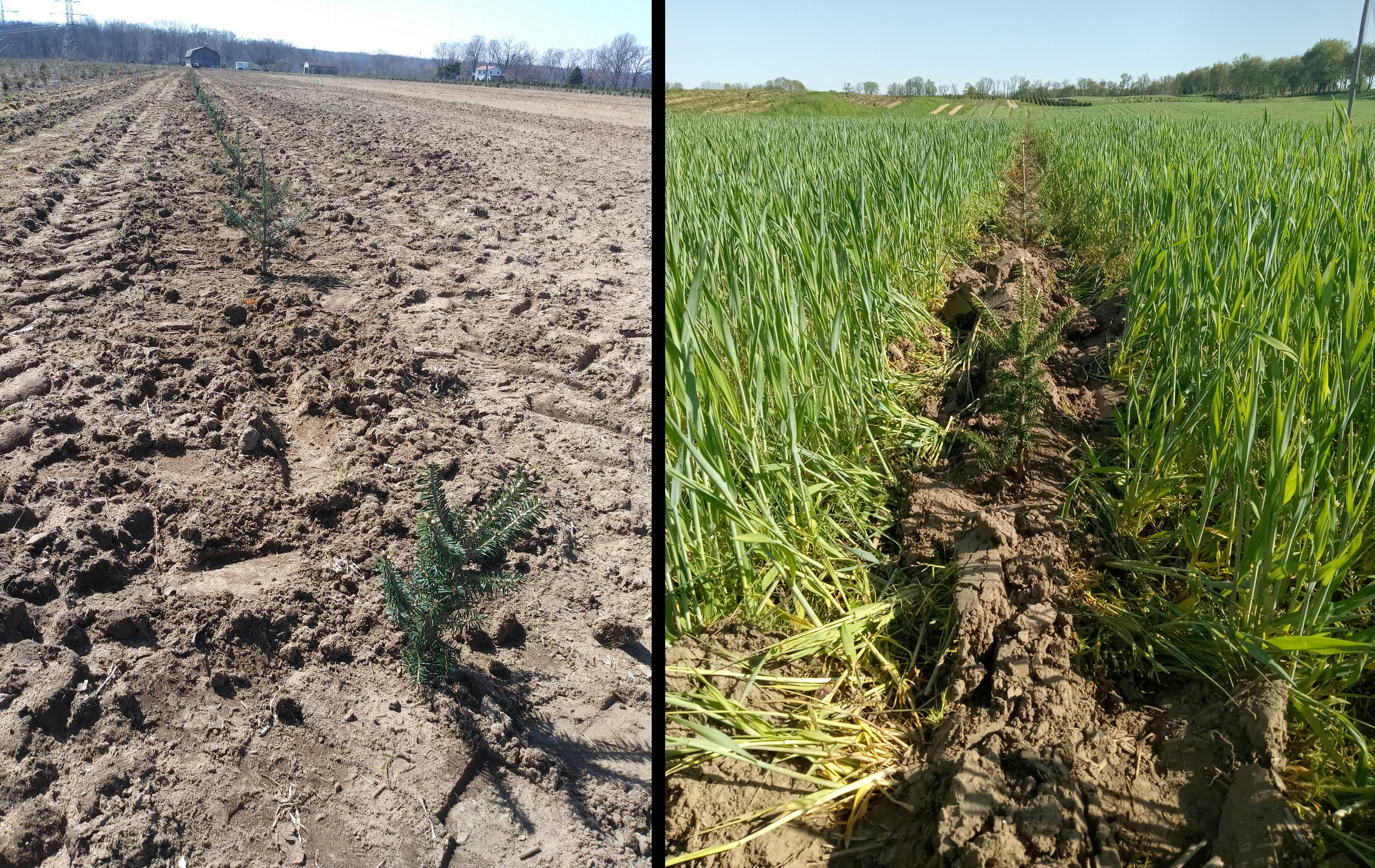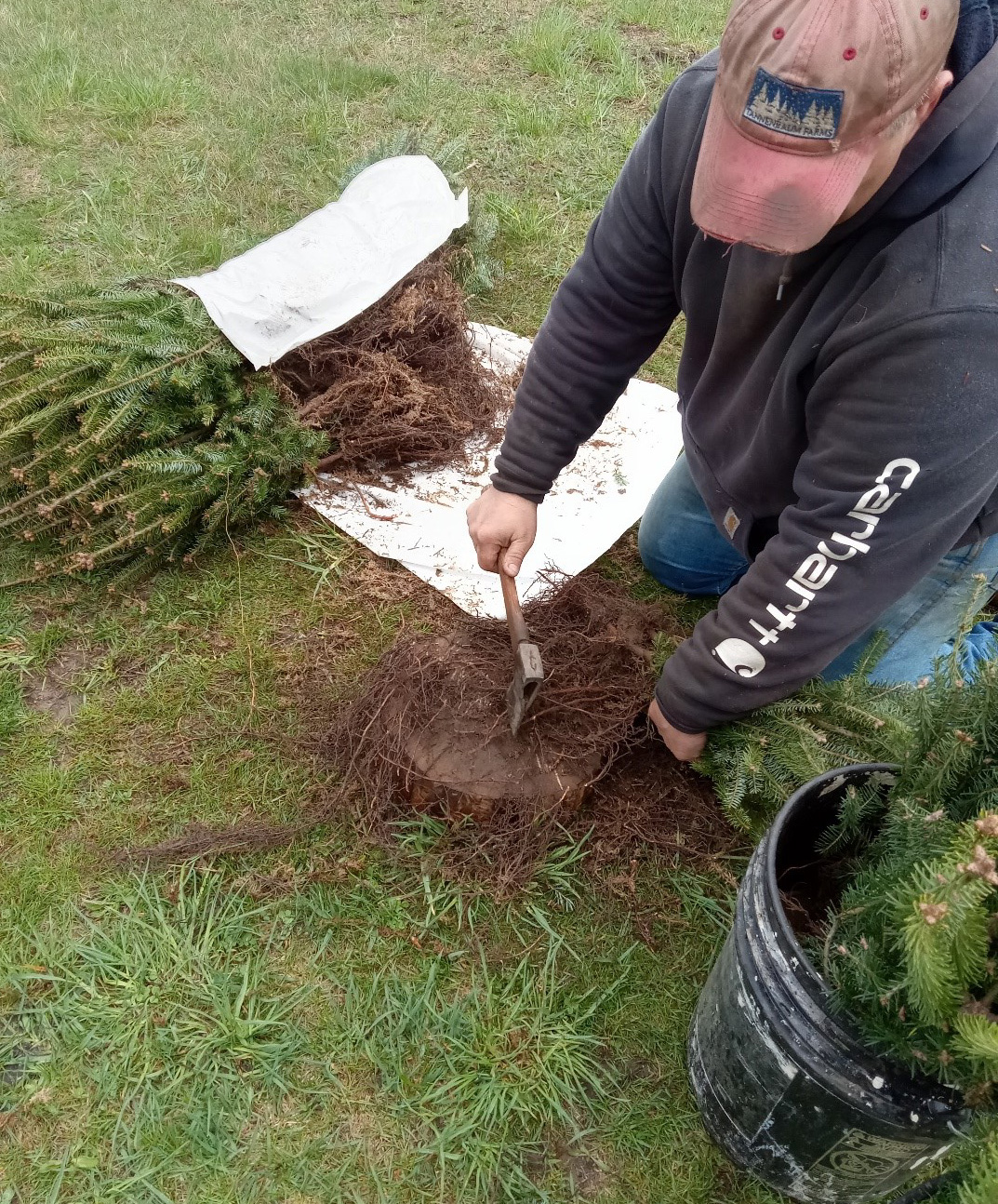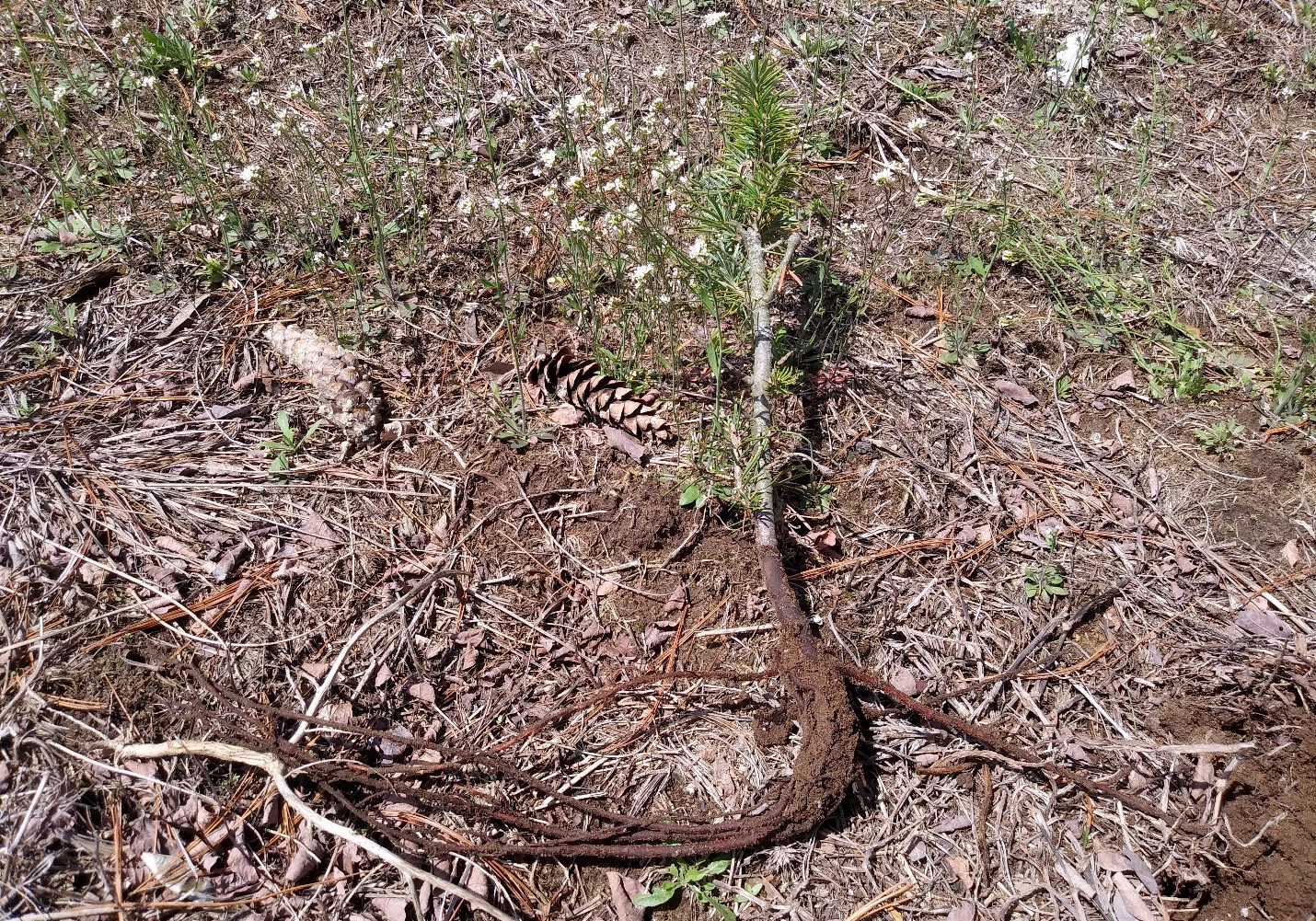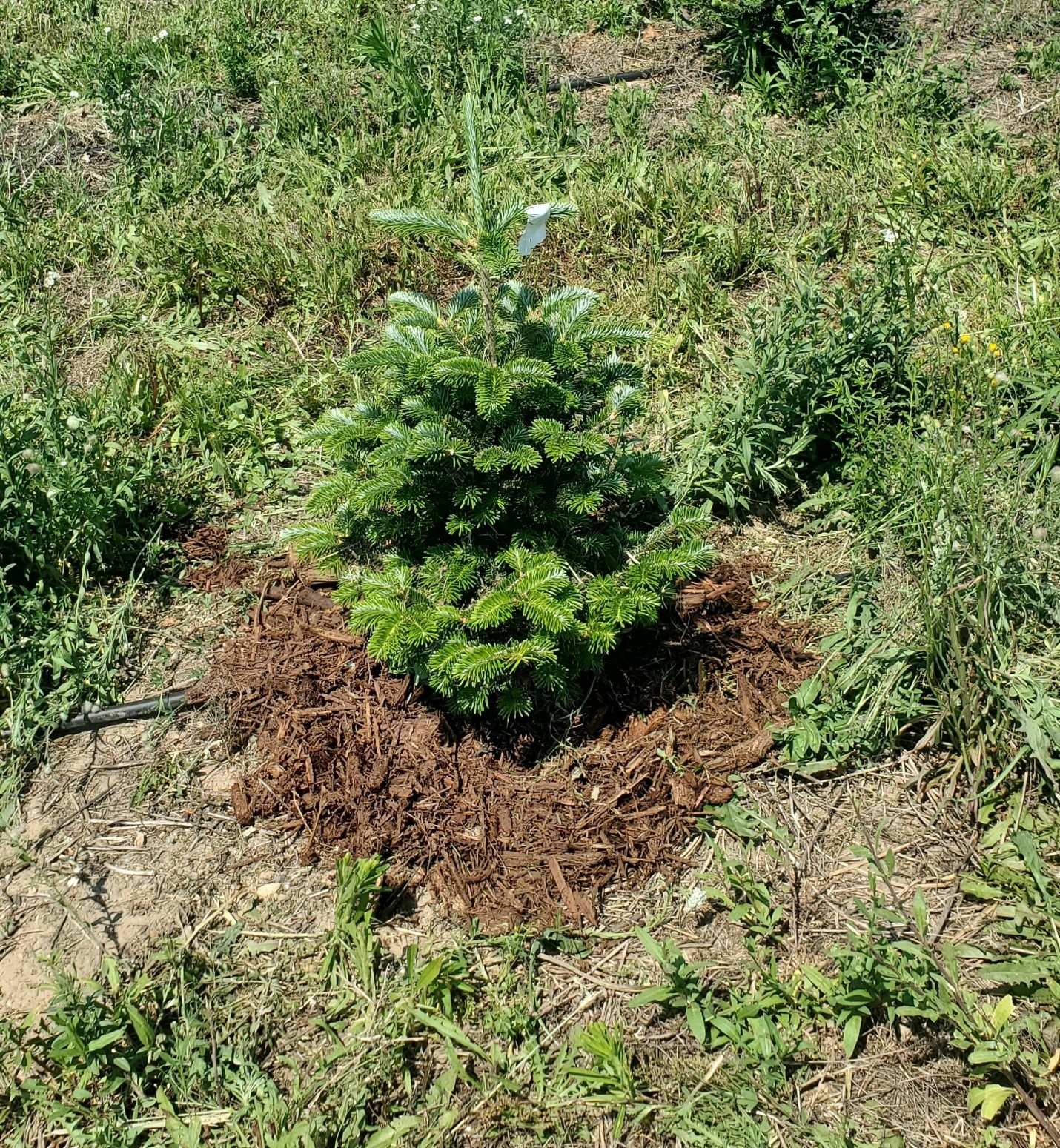Bulletin E3481
Christmas Tree Planting Guide (E3481)
August 8, 2023 - Bill Lindberg, Michigan State University Extension, and Bert Cregg, Michigan State University Departments of Horticulture and Forestry
This Document is offered in: English, Espanol
About Pesticides
This publication contains pesticide recommendations based on research and pesticide regulations. However, changes in pesticide regulations occur constantly. Some pesticides mentioned may no longer be available, and some uses may no longer be legal. If you have questions about the legality and/or registration status for using pesticides, contact your county MSU Extension office.
The information contained herein does not supersede the label directions. To protect yourself, others, and the environment, always read the label before applying any pesticide.

Reduce Tree Stress to Improve Establishment
Christmas tree seedlings and transplants experience a great deal of stress throughout the transplant process, and even in ideal conditions, some may die. If growers don’t prepare their fields adequately or if they use improper planting techniques, however, tree losses can increase dramatically. Fields with high tree mortality can be replanted, but it means you’ll pay more for trees, for labor to replant, and in time when the field is not producing.
Research, particularly on reforestation of conifer stands, has identified several critical steps in reducing transplant stress and improving tree survival and growth. We’ll discuss the steps in roughly chronological order in this bulletin, but note that controlling weeds and monitoring for tree damage will be important throughout the Christmas tree rotation.
- Control weeds.
- Match the trees to the site.
- Handle with care.
- Minimize exposure.
- Prune roots judiciously and dig the right hole.
- Check the planting depth.
- Add mulch.
- Skip the fertilizer.
- Monitor for tree damage.
Following the best practices outlined in this bulletin for field preparation, species selection, tree planting, and more can lead to greater tree planting success.
Control Weeds
Christmas tree transplants are vulnerable to weed competition. Fast growing weeds can easily outcompete transplants for light, nutrients, and most importantly, water (Saha et al., 2023). Inadequate weed control is often a leading cause of transplant mortality and poor tree establishment.
Eliminate weeds, especially perennial weeds, before planting. Identify the weed species that are growing at the site and tailor your weed control plan to control those species. A common method of accomplishing this is applying glyphosate in the fall before planting (Kuhns & Harpster, 2018). After planting, try to minimize weed pressure in the field, especially within a two-foot radius around each tree. Use a combination of chemical and nonchemical control methods for best results. Minimizing weed pressure is a priority for the entire length of the tree rotation.

Match the Trees to the Site
Planting tree species that are poorly suited to a site almost always results in poor establishment and growth. It is better to take time to identify and improve a site’s problems (such as drainage, soil pH, or overabundant weeds) before planting trees than it is to plant trees and then have to work around them to correct the site’s problems. Another option is to plant trees like pines and spruces that are more forgiving of site problems than are less broadly adapted species like Fraser fir.
Handle With Care
Trees are usually delivered in boxes or paper bags. Store and treat these transplant containers as you would containers of fresh produce. Whenever possible, store the packages in a cool, dark place, such as a walk-in cooler. Keep the tree roots moist, but don’t store them in standing water.
Plant the trees in the field as soon as you can after you receive them. If you need to store seedlings for longer than two weeks, place them in a V-shaped heeling-in trench (Stelzer, 2019).
Finally, be careful when moving boxes of transplants. Yuyitung et al. (1994) showed that trees in boxes that were dropped had reduced root growth after planting compared to trees in boxes that were not dropped.
Minimize Exposure
In Michigan, growers typically plant trees in the spring. The results of experiments comparing the establishment rates of spring and fall tree plantings have varied, with no clear best season for planting (Ellington, 1985; Sloan, 1989). However, planting in either spring or fall is better than planting in summer, when temperatures are higher and less soil moisture is available, resulting in poor establishment rates.
When planting day arrives, plant the trees as soon as possible after taking them out of storage. The unprotected roots of bare root trees can dry out quickly, especially on sunny, windy days (Edgren, 1984). Consider covering the tree roots with wet towels or rags to help keep them moist. In research trials, trees whose roots dried out before transplanting showed significantly less root growth after planting than trees whose roots stayed moist (Deans et al., 1990). Remember, it is better to make more trips back to the storage area to retrieve trees than to have them die in the field before they’re planted.
Prune Roots Judiciously & Dig the Right Hole
Many growers prune tree roots before planting. However, root pruning should only be done when roots are longer than the hole you are planting them into. As a rule, roots that are more than 10 inches long should be trimmed back to that length. Removing more roots than necessary will cause problems. Without an adequate root system, transplants won’t grow as well and will be more prone to drought stress.

When planting trees, avoid cramming large roots into a small hole. When this occurs, the tree roots will be compressed and will often grow in a “J” shape. J-rooted trees will not grow well, often languishing in the field or dying outright. This can happen whether the trees are planted with a mechanical tree planter or with handheld tools. Make sure to provide a large enough hole for each tree’s roots.

Check the Planting Depth
Plant the trees at the correct depth, which is with their root collars (the union of roots and shoots) at the soil surface. (That’s how they were growing as seedlings in the nursery bed.) If you plant the trees too shallow, their roots will be exposed and will dry out. If you plant them too deep, they may eventually die because their buried stems have rotted or because their roots have grown poorly.

Add Mulch
Many studies have shown that adding mulch around transplants can improve tree survival rates (Landgren et al., 2021; Cregg et al., 2009). Mulch has many benefits, including suppressing weeds, moderating soil temperatures, and increasing water retention in the soil (Cregg et al., 2009).
Many organic and inorganic materials can be used successfully as mulch. However, Saha et al. (2020) showed that large-textured softwood mulch controlled weeds better than fine-textured hardwood mulch.
Apply mulch a few inches thick, but avoid covering the tree stem, which can rot the bark and kill the tree. Mulch can be extremely useful when irrigation is not available. For example, in a trial at MSU’s Southwest Michigan Research and Extension Center, Cregg et al. (2009) found that:
- Trees that were mulched had similar survival and growth rates as trees that were irrigated.
- Trees that were either irrigated or mulched had significantly more growth compared to trees that received neither.
- Mulch did not reduce nutrient availability for trees.

Skip the Fertilizer
At least one year before planting, test your field’s soil to check its pH and nutrient levels. The interval is necessary for soil amendments to correct nutrient deficiencies or for adjustments in soil pH to take hold. Some tree species are extremely particular about soil pH and will not grow well when the pH is outside of their preferred range.
Transplants typically don’t need fertilizer the year they are planted. This is because trees usually have adequate nutrient reserves from fertilization at the nursery and other resources, especially water, are more limiting for tree establishment. Therefore, Extension experts in Michigan and in other Christmas tree-growing states recommend waiting until the second year after transplanting to start a nitrogen fertilization program.
Monitor for Tree Damage
There are many pests that can cause significant damage to Christmas tree transplants. Common issues for new plantings include insects that feed on tree roots (such as white grubs and root aphids), diseases that affect roots (like Phytophthora root rot), and animals that browse on the needles and branches, such as deer, rabbits, and voles. Maintain an active scouting program for these pests before, during, and after planting to determine the cause of any damage you find. This will help you decide on treatments to prevent or minimize the problem.
Adding It All Up
Successful tree plantings don’t happen by accident—they take detailed planning and foresight. This guide outlines key steps you can take to minimize tree stress and place your trees in the best environment to succeed. Tree plantings that have high survival rates and establish quickly are critical to the success of a Christmas tree business.
Find Out More
For more information about Christmas tree production in Michigan:
- Visit the “Christmas Trees” section of the MSU Extension website (canr.msu.edu/christmas_trees/).
- Contact your local MSU Extension office (extension.msu.edu/county).
- Visit MSU Extension’s “MSUChristmasTrees” channel on YouTube (https://www.youtube.com/user/MSUChristmasTrees).
Literature Cited
Cregg, B. M., Nzokou, P., & Goldy, R. (2009). Growth and physiology of newly planted Fraser fir (Abies fraseri) and Colorado blue spruce (Picea pungens) Christmas trees in response to mulch and irrigation. HortScience, 44(3), 660–665. https://doi.org/10.21273/HORTSCI.44.3.660
Deans, J. D., Lundberg, C., Tabbush, P. M., Cannell, M. G. R., Sheppard, L. J., & Murray, M. B. (1990). The influence of desiccation, rough handling, and cold storage on the quality and establishment of Sitka spruce planting stock. Forestry, 63(2): 129–141. https://doi.org/10.1093/forestry/63.2.129
Edgren, J. W. (1984). Nursery storage to planting hole: A seedling’s hazardous journey. In: Duryea, M. L., Landis, T. D., Perry, C. R. (eds). Forestry nursery manual: Production of bareroot seedlings. Forestry Sciences, vol 11. Springer, Dordrecht https://doi.org/10.1007/978-94-009-6110-4_22
Ellington, W. B. (1985). New ideas in fall planting. In Proceedings, Western Forest Nursery Council-Intermountain Nurseryman's Association Combined Meeting, August 14-16, 1984, Coeur D'Alene, Idaho (No. 185, p. 81). U.S. Department of Agriculture, Forest Service, Intermountain Research Station.
Kuhns, L., & Harpster, T. (2018). Weed control recommendations for Christmas tree growers. Pennsylvania State University Hort Mimeo Series II:128.
Landgren, C., Kowalski, J., & Cregg, B. (2021). Can treatments at planting improve noble fir seedling survival? Tree Planters’ Notes, 64(1): 32–38. USDA Forest Service & Southern Regional Extension Forestry. https://npn.rngr.net/npn/publications/tpn/64-1/can-treatments-at-planting-improve-noble-fir-seedling-survival
Saha, D., Marble, S., Pearson, B., Pérez, H., MacDonald, G., & Odero, D. (2020). Emergence of garden spurge (Euphorbia hirta) and large crabgrass (Digitaria sanguinalis) in response to different physical properties and depths of common mulch materials. Weed Technology, 34(2), 172–179. https://doi.org/10.1017/wet.2019.88
Sloan, J. P. (1989). Fall-lifted Douglas-fir outperforming spring-lifted stock 13 years after planting. Tree Planters’ Notes, 40(3), 20–24. USDA Forest Service and Southern Regional Extension Forestry. https://rngr.net/publications/tpn/40-3/fall-lifted-douglas-fir-outperforming-spring-lifted-stock-13-years-after-planting
Stelzer, H. (2019). How to plant forest tree seedlings (g5008). University of Missouri Extension. https://extension.missouri.edu/publications/g5008
Yuyitung, I., Simpson, J. A., & Gordon, A. M. (1994). Effects of rough handling on early performance of white pine and white spruce seedlings. Tree Planters’ Notes, 45(4), 142–146. USDA Forest Service and Southern Regional Extension Forestry. https://rngr.net/publications/tpn/45-4/effects-of-rough-handling-on-early-performance-of-white-pine-and-white-spruce-seedlings
Saha, D., Lindberg, B., & Sidhu, M. K. (2023). Weed control in Christmas trees (E3237). Michigan State University Extension. https://www.canr.msu.edu/resources/weed-control-in-christmas-trees-e3237



 Print
Print Email
Email


